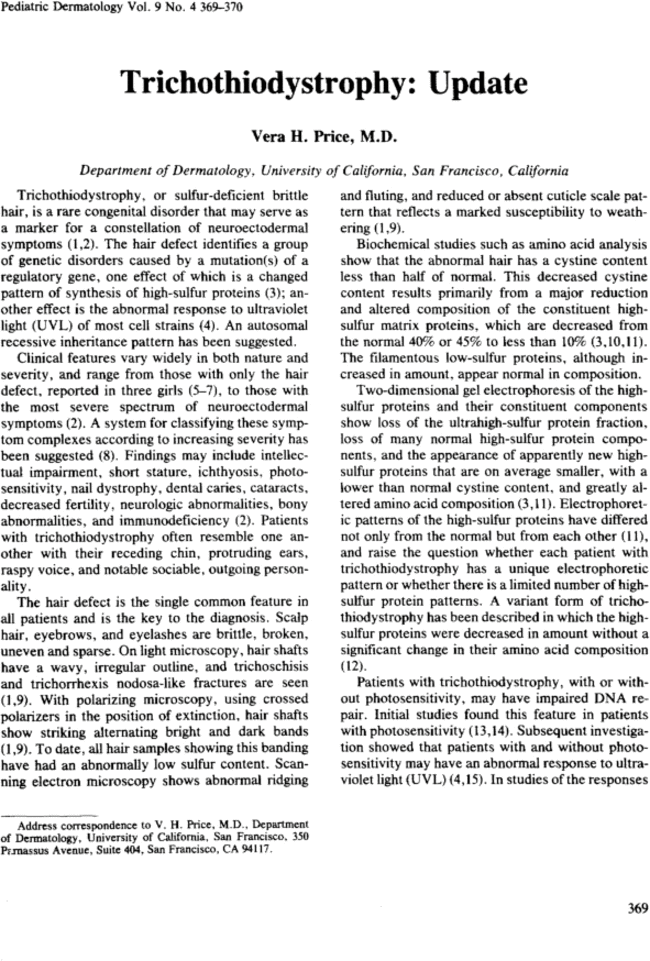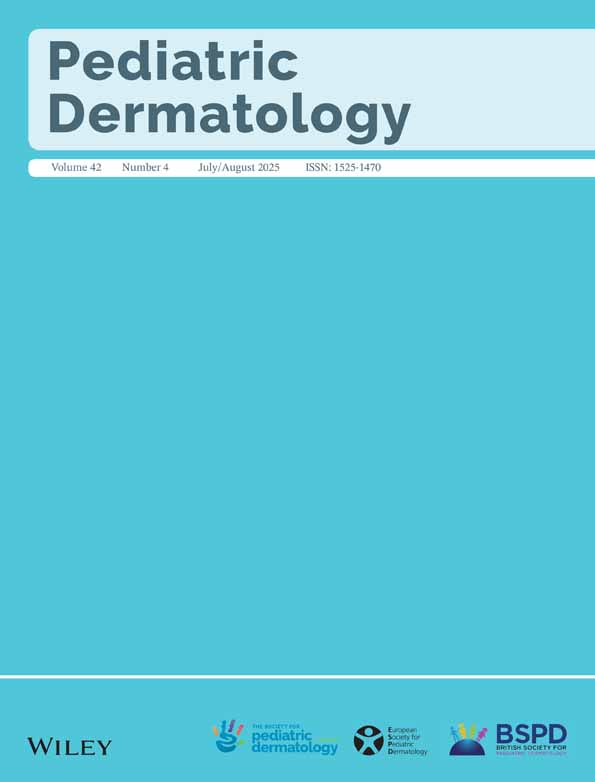Full Access
Trichothiodystrophy: Update
Vera H. Price M.D.,
Corresponding Author
Vera H. Price M.D.
Department of Dermatology, University of California, San Francisco, California
V. H. Price, M.D., Department of Dermatology, University of California, San Francisco, 350 Pamassus Avenue, Suit 404, San Francisco, CA 94117.Search for more papers by this authorVera H. Price M.D.,
Corresponding Author
Vera H. Price M.D.
Department of Dermatology, University of California, San Francisco, California
V. H. Price, M.D., Department of Dermatology, University of California, San Francisco, 350 Pamassus Avenue, Suit 404, San Francisco, CA 94117.Search for more papers by this author
REFERENCE
- 1 Price VH, Odom RB, Ward WH, Jones FT. Trichothiodystrophy. Sulfur-deficient brittle hair as a marker for a neuroectodermal symptom complex. Arch Dermatol 1980; 116: 1375–1384.
- 2 Itin PH, Pittelkow MR, Trichothiodystrophy: review of sulfur-deficient brittle hair syndromes and association with the ectodermal dysplasias. J Am Acad Dermatol 1990; 22: 705–717.
- 3 Gillespie JM, Marshall RC. A comparison of the proteins of normal and trichothiodystrophic human hair. J Invest Dermatol 1983; 80: 195–202.
- 4 Lehmann AR, Arlett CF, Broughton BC, et al. Trichothiodystrophy, a human DNA repair disorder with heterogeneity in the cellular response to ultraviolet light. Cancer Res 1988; 48: 6090–6096.
- 5 Brown AC, Belser RB, Crounse RG, Wehr RF. A congenital hair defect: trichoschisis with alternating birefringence and low sulfur content. J Invest Dermatol 1970; 54: 496–509.
- 6 Baden HP, Katz A. Trichothiodystrophy without retardation: one patient exhibiting transient combined immunodeficiency syndrome. Pediatr Dermatol 1988; 5: 257–259.
- 7 Milligan A, Fletcher A, Porter DI, Hutchimson PE. Trichothiodystrophy. Clin Exp Dermatol 1991; 16: 264–267.
- 8
Van Neste D,
Miller X,
Bohnert E.
Clinical symptoms associated with trichothiodystrophy: a review of the literature with special emphasis on light sensitivity and the association with sere-derma pigmentosum (complementation group D). In: D Neste,
JM Lachapelle,
JL Antoine, eds.
Trends in humanhair growth and alopecia research.
Dordrecht
: Kluwer Academic Publishers, 1989; 183–93.
10.1007/978-94-011-7873-0_19 Google Scholar
- 9
Price VH.
Structural anomalies of the hair shaft. In: CE Orfanos,
R Happle, eds.
Hair and hair diseases.
Berlin
: Springer-Verlag, 1990: 363–422.
10.1007/978-3-642-74612-3_15 Google Scholar
- 10 Pollitt RJ, Stonier PD. Proteins of normal hair and of cystine-deficient hair from mentally retarded siblings. Biochem J 1971; 122: 433–434.
- 11 Gillespie JM, Marshall RC, Rogers M. Trichothiodystrophy—biochemical and clinical studies. Aust J Dermatol 1988; 29: 85–93.
- 12
Van Neste D,
Degreef H,
Van Haute N, et al.
High sulfur protein deficient human hair clinical aspects and biochemical study of two unreported cases of a variant type of trichothiodystrophy. In: D Neste,
JM Lachapelle,
JL Antoine, eds.
Trends in human hair growth and alopecia research.
Dordrecht
: Kluwer Academic Publishers, 1989: 195–206.
10.1007/978-94-011-7873-0_20 Google Scholar
- 13 Van Neste D, Caulkr B, Thomas P, Vasseur F. Tay's syndrome and xeroderma pigmentosum. J Am Acad Dermatol 1965; 12: 372–373.
- 14 Crovalo F, Rebora A. PIBI(D)S syndrome: a new entity with defect of the deoxyribonucleic acid excision repair system. J Am Acad Dermatol 1985; 13: 683–685.
- 15 Lehmann AR. Cockayne's syndrome and trichothiodystrophy: defective repair without cancer. Cancer Rev 1987; 7: 82–103.




